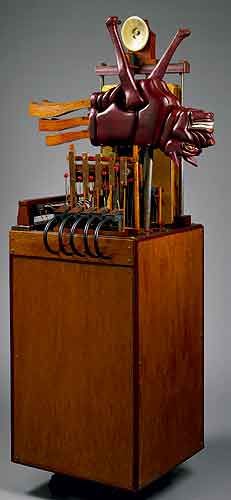

Interview with John Gaughan who restored "Tap Dancer".
AN INTERVIEW WITH STEPHAN VON HUENE
ON HIS AUDIO-KINETIC SCULPTURES
Dorothy Newmark*
* Computer artist living at 820 Hermosa Drive, N.E., Albuquerque, N.M. 87110, U.S.A. (Received 22 November 1969.)
Interviewer's note—Stephan Von Huene was born in Los Angeles, California in September 1932 and is currently residing there at 1336 Sutherland Ave. He studied art at Chouinard Art Institute in Los Angeles and at the University of California at Los Angeles [1-4]. He teaches at present at the California Institute of the Arts in Valencia, California.
Newmark—'Tap Dancer' (1969) is your latest audio-kinetic sculpture. Do you feel it is the culmination of a period in your work?
Von Huene—All of the sculptures that were in my 1969 exhibit at the Los Angeles County Museum of Art were the culmination of a certain direction; that is, the use of biomorphic forms activated by a player-piano mechanism and accompanied by music.
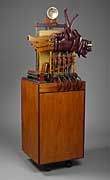
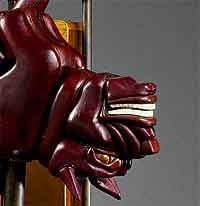
`Kaleidophonic Dog' (1967) was my first machine to operate successfully. A dog is lying on its back with parts of it moving, accompanied by sounds of a wooden drum, 8 organ pipes and a xylophone. Used in the machine are five loops of 2 in. tape with perforated programs that move along a tracker-bar arrangement. The pneumatic system causes parts to move and the drum, organ pipes and xylophone to produce sounds.
N. Would you describe the mechanism you use?
V. H. The basic part of it is a valve that acts like a switch and a tracker bar over which rides a perforated tape. When the perforations in the paper tape line up with holes in the tracker bar,it turns on the valve switch and allows air to be pumped out of
a small bellows that has a hammer attached to it. The hammer may hit a drum or it may operate another small bellows that opens a palate valve connected to one or more organ pipes. The organ pipes are operated by an air blower. The perforated tape, or several of them, can be rewound automatically; the system can also be operated during the rewinding phase. If anyone is interested in the details of the system I use, I would be glad to provide them.
N. What led you to use the player-piano mechanism ?
V. H. I was at first simply interested in finding out how it worked. I found that the 11.5 inch player-piano paper strip was too wide for my purposes and now use a 2 in. paper tape. I punch holes in the tape at random or with a specific program of sounds in mind. I would like to make it possible for anyone to prepare the tapes, so they would produce sound combinations to suit themselves—either ordered sound sequences, which are, I suppose, what we call music or haphazard sound arrangements.
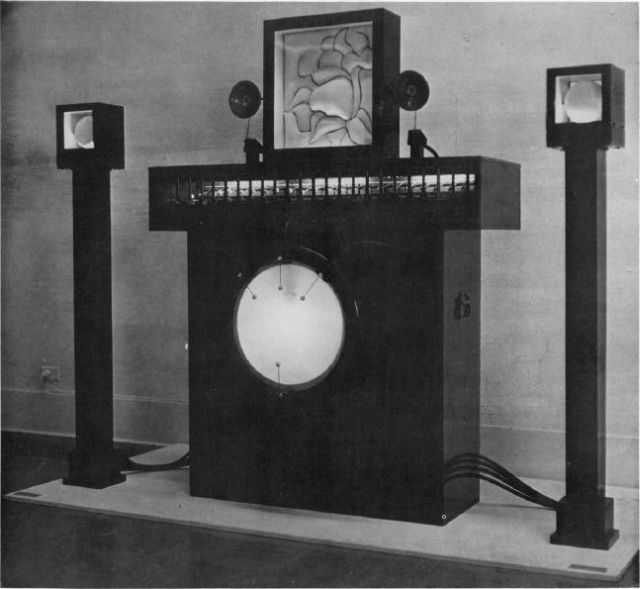
N. Would you describe your most recent piece, `Rosebud Annunciator' (1969).
V. H. It has an overall appearance of early California architecture, heavy and oak-furniture-like, an influence that stems from a very romantic part of my early life in Pasadena, California. On top of the machine is a leather rose, made up of sixteen sections that can be inflated and deflated. Then, on each side there is a post with an inflatable, deflatable leather sphere in a box on top of it, connected by tubing to the pneumatic system. The center part is made of a large xylophone with twenty-four notes, two cymbals, a drum and an octave of reeds.
N. I note that 'Rosebud' is 7 ft high and 8 ft wide. What led to the center part being so large, was it the xylophone ?
V. H. The xylophone determined the width but it was the pneumatic system underneath it that brought about the rather large height.
N. Tell me how you incorporated inflatable parts with sound producing elements in this audio-kinetic sculpture.
V. H. First, I made the rose as a relief in wood. Then I formed over it separate pieces of leather. Later, I mounted these pieces so that the assembled form could be activated by air pressure. The motion of the rose and the sounds are controlled by the player-piano mechanism and the roll, both when it unwinds and rewinds. The roll rewinds faster than it unwinds in this machine. While the roll unwinds the animation of the rose and the spheres is slow, monotonous, ceremonial, then on the rewind there is a fast jumble that gives the feeling that the machine is falling apart amidst a din of sounds.
N. Has anyone commented on the sounds emitted by 'Rosebud' ?
V. H. In the fall of 1968, I was asked to exhibit `Rosebud' in the Electromagica Exhibition in Tokyo. That was an international exhibition of art objects using electricity. It was organized by the Japan Electric Arts Association. At the show I met a Chinese scholar who said that he noted with interest that my machine was playing Japanese music. I explained to him that I had based the music, more or less, on Bach's 'Two-Part Invention' and the beat was related to some of the music composed by Stravinsky. Perhaps this combination sounds Oriental to some. To me the beginning part sounds a little like the music I heard in Vera Cruz, Mexico. The end, as I said before, is a jumble of sounds, nevertheless, the complete program has, I believe, a certain kind of consistency which I enjoy.
N. Did it take you a long time to complete `Rosebud' ?
V. H. Approximately two years—'Kaleidophonic' Dog' took three years. 'Washboard Band' and 'Tap Dancer' each took me only six months to complete.
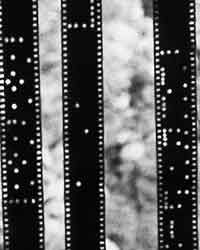
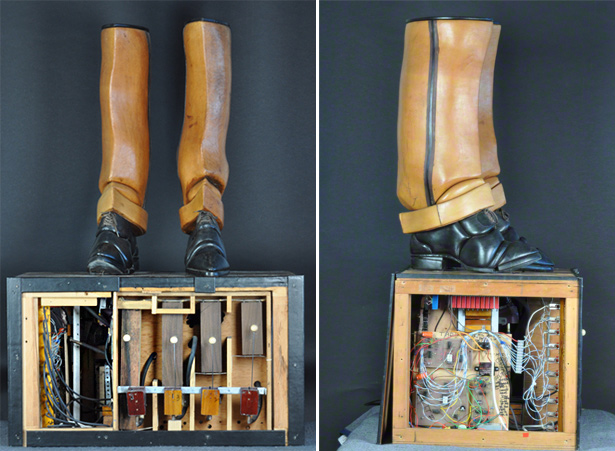
N. Would you give some details on 'Tap Dancer' and 'Washboard Band' ?
V. H. 'Tap Dancer', as you can see in the photograph, consists of the legs of a man below the knees. The shoes are a bit odd looking. The legs oscillate in clockwise and counter-clockwise directions, while the toes of the shoes go up and down. The toes are connected pneumatically to wood blocks inside the supporting box to make tapping sounds against the top of the box. The sculpture is programmed by a tape loop that lasts about 4 minutes and it automatically plays over and over.
`Washboard Band' consists of two major elements. The taller column supports an ordinary laundry washboard upon which beat four sticks. There is also a sliding piece that moves
horizontally, back and forth, to produce a rasping sound. Above the washboard is a cymbal and a cow bell, which are struck periodically. On the top of the shorter column, there is a plastic box containing reeds that vibrate when air is blown past them. (The air also moves leather strips above the reeds.) The sculpture is programmed by two tape loops of different length. With each revolution of the loops the program on each tape phases into a new relationship.
N. Do you have some new ideas you want to apply to your audio-kinetic sculptures?
V. H. Yes. I want to handle the whole sculptural lay-out in a different, simpler way. Also I want to use different sound-producing objects that produce less well-known sounds. I'll still use wood and leather for some moving parts, as I find them satisfactory materials—I used wood and leather even before I started to make audio-kinetic sculptures. When I became interested in player piano mechanisms and organ pipes, I found they also had wood and leather parts. I believe I have improved the old systems for sucking and pumping air both to activate pneumatic parts and to produce various kinds of sound. When I made figurative sculpures in the past, I used wood covered with leather rather than with paint. You may find it surprising that I also used bread instead of wood because I like its tactile, sensual qualities.
N. But is bread sufficiently durable?
V. H. I made it durable. After the bread formed, I dried it and covered it with resin. Sometimes, I used fresh dough and allowed the rising of the dough, caused by the action of yeast, to fill a desired shape. I enjoyed working with a material that has life-like properties. I became quite obsessed with bread for a while. I wrote stories on paintings I had seen that seemed to me to be all bread. People seemed to be all bread. It was as if they became what they ate. No doubt, a very primitive attitude on my part. Why make images of people out of stone, of metal? Why not make them out of bread or leather? Certainly, these materials are most appropriate for making images mimicking people.
[Source: Kinetic Art: Frank Molina- Leonardo Magazine – Dover Press]
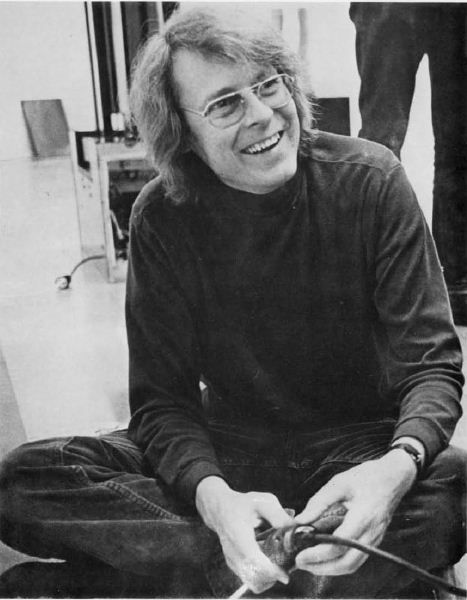
STEPHAN VON HUENE
Animation by Allan Kaprow
Born 1932 in Los Angeles, California. Graduated from Chouinard Art Institute in 1959, and received M.A. from the University of California. Los Angeles in 1965. Currently Associate Dean of the School of Art, California Institute of the Arts.
Current art is often made of absences: absence of purpose, absence of meaningful connection between things, absence of material and conceptual definition, absence of elaboration, absence of professionalism, absence of uplifting values, absence of personal identity, absence, even, of pathos. Artists seem intrigued by these gaps, these meta-states that leave things blankly self-evident or connected in perfunctory series like the numbers in a traffic count.
Stephan von Huene's art is one of presences. Not simply the physical presences of well-crafted objects, inventive and focused for eyes and ears; but, rather, 'magical' presences. Here are beings, surrogates for ourselves, who perform for a time and then are mute until requested to act and speak again. Oracles. They communicate in crypto-syllables from a language just beyond translation. They emit hoots, moans, clicks, beeps and breathy sounds, punched out on hidden paper tapes and run by vacuum sweeper motors. I've seen them in their mahogany dusk. Lights shine from their insides. Ceremonies.
For instance: A one-man band without the man who is the band, mechanically having become the band, plays for itself in an empty room. A white rose. Presence of the absence.
And: A vaudeville team in some bar in 1920 where for a nickel in a slot they'll rag, rattle, tonkle, scrape and blow. Washboard face with cowbell feather. Guardian Nickelodeon. Very serious. Mutt and Jeff at attention.
And: Enormous shoes of the clubfoot dandy, tapping away nifty twist of the hard-tipped toes under heavy folded cuffs. Insidious dance to the music we refuse to hear so we listen to the tappety tap of the man we won't see. Tappety
And: Erect wooden columns, alone, in pairs, threes and more (NYC office buildings), floating on contained light, totems intoning cadences of windy stories spoken to the shivering back. Jokes. Jokes you don't laugh at since you don't know when. (Meditative punch-lines.) Squared lips mouthing them, saying something known but forgotten. Dead-pan. Elegant. Ancestor.
Von Huene's art is located at a point just between those turn-of-the-century fantasies of machines that come alive, and archetypal evocations that reach beyond time. It thus escapes both the topicality of modernism and the datedness of the recent past. There is no nostalgia in his beings who articulate their own existence almost didactically and "in tongues." They seem on their own, stylistically removed from now just enough to perform without either necessity or apology. They are perhaps even a little smug in their mystery. What they are not, that is, what is absent, is of no importance to them. It is what makes their magic so potent.
[Source: Sound Sculpture, Grayson – see pdf here.]
See article on Tap Dancer restoration here.
See other Pneumatic, Fluidic, and Inflatable robots here.
What a interesting article. I have always been interested in the Kaliedophonic Dog.